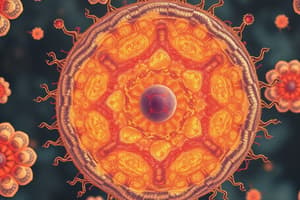Podcast
Questions and Answers
What is the function of the plasma membrane in a cell?
What is the function of the plasma membrane in a cell?
- Stores genetic information
- Transcribes RNA
- Regulates what enters and leaves the cell (correct)
- Produces energy for the cell
Which type of cell has a true nucleus and multiple membrane-bound organelles?
Which type of cell has a true nucleus and multiple membrane-bound organelles?
- Single-celled organism
- Prokaryotic cell
- Animal cell
- Eukaryotic cell (correct)
What is a common feature shared by all cells?
What is a common feature shared by all cells?
- Inability to reproduce
- Absence of cytoplasm
- Lack of a plasma membrane
- Presence of genetic material (correct)
Which type of cell has a more complex structure and a protective protein called histone?
Which type of cell has a more complex structure and a protective protein called histone?
What is the main difference between prokaryotic and eukaryotic cells?
What is the main difference between prokaryotic and eukaryotic cells?
Which component of a cell is responsible for containing nutrients, waste products, and various organelles?
Which component of a cell is responsible for containing nutrients, waste products, and various organelles?
What is the primary function of mitochondria in a cell?
What is the primary function of mitochondria in a cell?
Which organelle is responsible for synthesizing proteins based on mRNA instructions?
Which organelle is responsible for synthesizing proteins based on mRNA instructions?
What is the main role of the cell membrane?
What is the main role of the cell membrane?
Which organelle governs protein secretion, lipid synthesis, and detoxification within a cell?
Which organelle governs protein secretion, lipid synthesis, and detoxification within a cell?
What is the function of vacuoles in a cell?
What is the function of vacuoles in a cell?
What is the composition of the cell membrane?
What is the composition of the cell membrane?
Flashcards are hidden until you start studying
Study Notes
Cells
Cells are the fundamental units of life. They are microscopic structures composed of various components, including proteins, carbohydrates, lipids, nucleic acids, water, and other organic compounds. There are two main types of cells: prokaryotic and eukaryotic. Prokaryotes, such as bacteria, have relatively simple structures without a defined nucleus or other membrane-bound organelles. Eukaryotes, which include animals, plants, fungi, and protists, have a more complex structure with a true nucleus and multiple membrane-bound organelles.
Cell Structure
Components of Cells
All cells share similar features, including:
- Plasma membrane: A selectively permeable barrier that regulates what enters and leaves the cell.
- Cytoplasm: A jellylike substance containing nutrients, waste products, and various organelles.
- Genetic material: DNA or RNA that carries the genetic information of the cell.
Prokaryotic and Eukaryotic Cells
Prokaryotic cells consist of a single circular chromosome that contains all the genetic information. They also have a few other chromosomes that are not part of the main genetic material. Eukaryotic cells, on the other hand, have a nucleus that is surrounded by a membrane called the nuclear envelope. Inside the nucleus is a protective protein called histone, which helps protect the DNA from damage.
Cell Function
Cells perform several functions essential for life, including growth, reproduction, metabolism, response to stimuli, and maintenance of homeostasis. These functions involve the interaction between different organelles within the cell. For instance, the mitochondria produce energy through a process known as cellular respiration, while the ribosomes synthesize proteins based on instructions encoded by mRNA.
Organelles
Organelles are specialized structures within cells that carry out specific tasks. Some important organelles include:
- Nucleus: Contains genetic material that codes for all proteins made by the cell.
- Mitochondria: Produce most of the cell's supply of ATP, the primary source of energy.
- Ribosomes: Synthesize proteins using instructions given by mRNA.
- Endoplasmic reticulum (ER): Governs protein secretion, synthesizes lipids, detoxifies harmful materials, and assists in calcium storage.
- Golgi apparatus: Modifies, sorts, packages, and transports vesicles, lipids, and proteins.
- Vacuoles: Store food, waste products, and other liquid materials.
Cell Membrane
The cell membrane is a crucial component of both prokaryotic and eukaryotic cells. It consists of a phospholipid bilayer, which has a hydrophilic outer surface and a hydrophobic inner surface. The cell membrane serves several roles:
- Separation of internal and external environments: Controls what can enter and leave the cell.
- Protection of cell contents: Shields against physical and chemical stressors.
- Transport of molecules: Regulates the movement of substances across the membrane.
In conclusion, cells are the basic building blocks of life, performing vital functions through their intricate structure and diverse organelles. Understanding these aspects of cells is crucial for studying biological processes and developing new technologies.
Studying That Suits You
Use AI to generate personalized quizzes and flashcards to suit your learning preferences.




